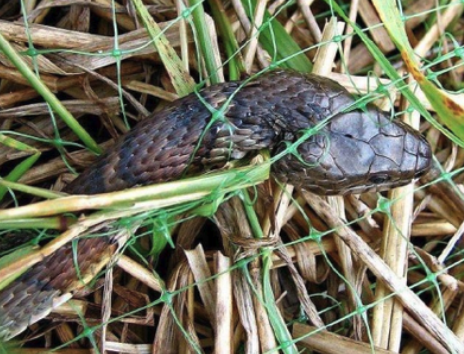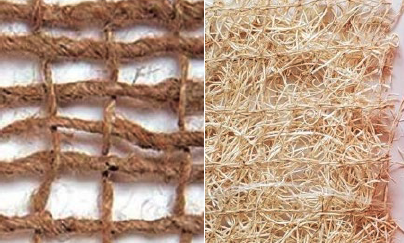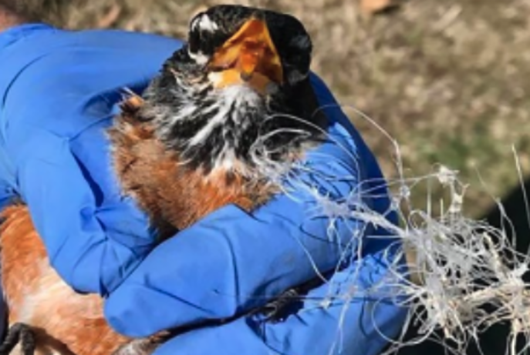As the earth’s soils continue to get bombarded with plastics that saturate and pollute, impacting agricultural production and threatening both wildlife and human health, Departments of Transportation (DOTs) like Idaho’s are pivoting to environmentally friendly solutions that reduce plastics in our environment. The picture above shows a robin entangled in netting. The picture below and to the right shows a snake similarly entangled.
For instance, biodegradable erosion blankets (like the ones seen below) are being used in projects that do not harm or entangle wildlife. The natural fiber blankets have loose-weave without joints, allowing snakes and other wildlife to easily move over or through natural fibers. Erosion and Sediment Control (ESC) practices are used to prevent soil loss and reduce sediment-laden stormwater runoff. These practices used in construction, maintenance and operations can be temporary or permanent. Biodegradable material will decompose under ambient soil conditions into carbon dioxide, water, and other naturally occurring materials within a time period relevant to the product’s expected service life.

Older “photodegradable” plastics can still be intact a decade after construction if vegetation prevents sunlight from breaking down the plastic. When these photodegradable plastics do break down, they continue to be a hazard to natural ecosystems as a micro-plastic. In contrast, biodegradable products typically degrade within 1 to 2 years into naturally occurring substances.
Plastics are commonly used for ESC due to their availability, durability, and cost, but they are rarely recycled, ending up in landfills or breaking down into micro-plastics, which are an emerging pollutant of concern. Pieces of plastic netting can contaminate waterways and interfere with aquatic resource. Plastic erosion control products can ensnare and kill fish and wildlife, interfere with highway mowing equipment, create garbage, and result in added costs for removal and disposal. Concerns about human health impacts are also major concern. Research has shown that plastics in soils can serve as vectors for chemicals and pathogens harmful to human health. They can also disrupt soil biology and crop establishment, which could negatively impact food security.
According to Stormwater magazine in May 2021, at least 21 DOTs have either phased out plastic ESC products or would like to, according to a national virtual peer exchange held in November 2020 on reducing plastics. As such, many DOTs have or are working toward innovative practices involving reducing plastic-based products used in ESC and other toxins from erosion control products. DOTs use various ESC products such as rolled erosion control (erosion blankets), fiber wattles and rolls, and hydraulically applied erosion control products. Factors such as availability, cost, performance, and sustainability are considered.

Minnesota DOT estimates that over 30 tons of plastic annually are placed on their roadsides from erosion and sediment control products alone. These plastics come from woven plastic netting or fabrics commonly deployed as part of transportation projects on open ground and near water to protect soils from erosion and retain sediment. in 2017, Washington State’s DOT began requiring “natural plant fiber unaltered by synthetic material” in its erosion and sediment control best management practices
“As more DOTs require the use of natural, biodegradable products, the upfront costs of purchasing the product are expected to decrease based on efficiency of scale,” Cathy Ford explained. Ford is ITD’s Roadside Program Administrator.

